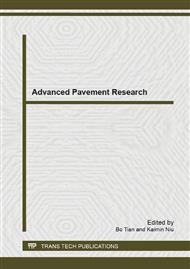p.3
p.10
p.20
p.27
p.35
p.42
p.51
p.56
Study on the Influence of Mix Design Parameters on the Properties of Self-Compacting Concrete
Abstract:
the influence of mixing amount of mineral admixture, volume content of fine and coarse aggregate have been systematical studied on the workability, mechanical properties and volume stability of self-compacting concrete. Test results showed that with the fly ash content increased, the workability of self-compacting concrete improved significantly, early compressive strength decreased, but increase rate of later strength improved remarkably, and the mixing amount of fly ash inhibited significantly the dry shrinkage of self-compacting concrete; with the volume content of coarse aggregate increased, the workability of self-compacting concrete decreased significantly, but the volume stability of self-compacting concrete improved obviously, thus the optimum volume content of coarse aggregate of self-compacting concrete was range from 0.30 to 0.34; when the volume content of fine aggregate varied at the range of 0.40~0.50, there may be little effects on the workability of self-compacting concrete, but the increase self-compacting concretes volume content could reduce obviously the dry shrinkage of self-compacting concrete. Moreover, the variation in the volume content of coarse and fine aggregate should have slight influence on the early strength of self-compacting concrete, and the influence of the volume content variety on the later strength of self-compacting concrete could be neglected eventually.
Info:
Periodical:
Pages:
10-19
Citation:
Online since:
December 2013
Authors:
Keywords:
Price:
Сopyright:
© 2014 Trans Tech Publications Ltd. All Rights Reserved
Share:
Citation:


